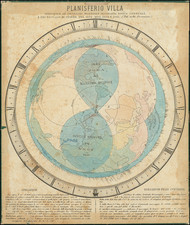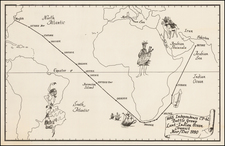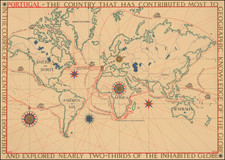Early Photograph of the 1351 Medici-Laurentian World Map, from the Collection of Edward Luther Stevenson.
A wonderful early photographic facsimile of the famous and very important world map from the Medici-Laurentian Atlas of 1351. The map, composed by an anonymous Genoese cartographer, is probably the earliest extant image to incorporate the travel reports of Marco Polo and Ibn Batuta. It is also an extremely early rendering of the correct shape of Africa, with the Gulf of Guinea, Cape of Good Hope, and the entrance to the Indian Ocean from the Atlantic all correctly rendered.
This photograph is interestingly filtered to reduce the prominence of the deep blue lapis-colored oceans, so that the thin tracing of an alternative African coastline can be more easily recognized.
Jim Siebold recounts the importance of the map's African cartography thusly:
Among the most startling features is its depiction of the recognizable shape of the continent of Africa with remarkable prescience. Nearly a century before the Portuguese age of discovery, the Medici Atlas draws the bend of the Gulf of Guinea and shows that Africa has a southern end, i.e. that the Atlantic and Indian Oceans are connected to each other below the African continent, a delineation that has given rise to a variety of inferences. At one extreme comes the view of Alexander von Humboldt that this work, in conjunction with others, offers clear proof of a medieval acquaintance with the southern part of Africa. “A long time before Bartholomew Dias and Vasco da Gama we find,” he asserts, “the triangular extremity of Africa represented in the Portolano della Medico Laurenziana”. Historian A.E. Nordenskiold endorses this opinion when he declares that the Africa of the Medicean Atlas is “more correct than the map drawing of Africa.... on Behaim’s Globe and on the map by Martellus Germanus” (#256 and #258). At the other extreme Santarem, the Portuguese savant, declares that this document and all of the same century (i.e., 14th century in his view) “constatent l’indubitable priorite de nos decouvertes et prouvent qu’avant ces decouvertes la cate occidentale de l’Afrique qui s’etend audela du dit Cap (Bojador) etait absolument inconnue aux cosmographes.” [find the undoubted priority of our discoveries and prove that prior to these discoveries the Western coast of Africa that stretches from audela to Cape (Bojador) was absolutely unknown to cosmographers]. Between these opposed theories come those of more recent scholars. De la Ronciere, for instance, speaks of the map with its “prescience de la forme reelle de l’Afrique avant le periple Portuguais” [foreknowledge of the actual shape of Africa before the Portuguese exploration]. Wieser takes a similar view. C.R. Beazley is inclined to credit the author with knowledge of the southeastern extension of the continent, but Laurentian Sea Atlas, or, the Medicean Atlas #233 2 concerning the west coast he says: “We require names of bays and headlands, we look for more definite proof of knowledge of the shoreline .... If its merits (between Sierra Leone and the end of the continent) are not accidental, they are probably due to information of the vast southward extension of Africa brought to Europe by men who had visited the Moslem settlements of the East Coasts or who had conversed with others who came from that region.”
The Edward Luther Stevenson Collection
Edward Luther Stevenson was among the most important scholars of early cartography active at the end of the 19th century and the first half of the 20th. He was responsible for numerous cartobibliographic books, including the first translation of Ptolemy to English, as well as a series of impressive facsimile maps produced while he was at the Hispanic Society of New York. Dr. Stevenson viewed facsimiles as integral to the study of early cartography, and he committed himself to building an unparalleled collection of photographs of early maps and globes. Much of his collection was donated to Yale University after his death (click on the title link above for about that), but the present item comes from a large collection of photos, manuscripts, and related material that were part of Stevenson's library, but were not donated to Yale. It is truly an impressive collection and many of the items, though reproductions, have serious antiquarian merit. As Alexander O. Vietor said about Stevenson collection that went to Yale "this is the stuff of which great libraries are made."












![[Second World War-era Japanese Pencil Sharpener Map of the World]](https://storage.googleapis.com/raremaps/img/small/84609.jpg)
![Hemisphere Occidental ou du Nouveau Monde . . . [and] Hemisphere Oriental ou de L'Ancien Monde . . . MDCCLXI](https://storage.googleapis.com/raremaps/img/small/64273.jpg)
![[Rare Complete Example with Game Pieces] Grand Circuit Des Capitales. Collection Concours Du Chocolat Menier](https://storage.googleapis.com/raremaps/img/small/70922rd.jpg)